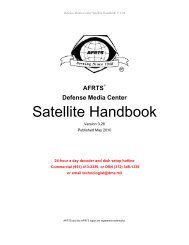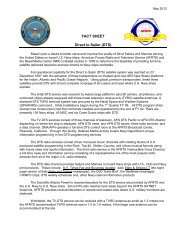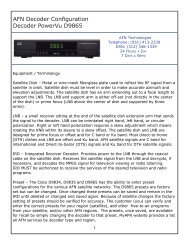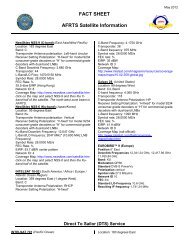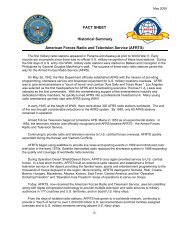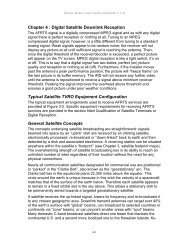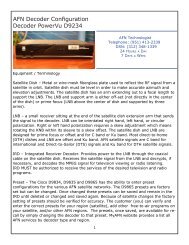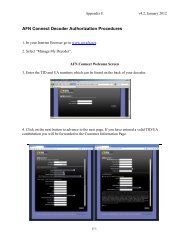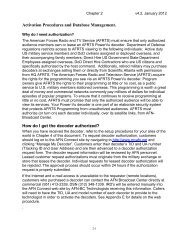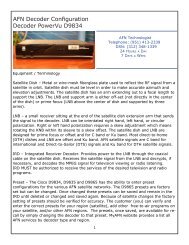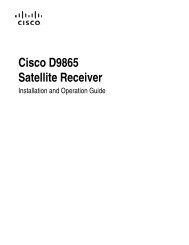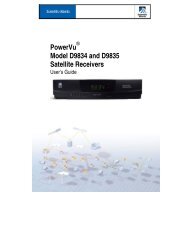AFRTS Defense Media Center Satellite Handbook
AFRTS Defense Media Center Satellite Handbook
AFRTS Defense Media Center Satellite Handbook
You also want an ePaper? Increase the reach of your titles
YUMPU automatically turns print PDFs into web optimized ePapers that Google loves.
<strong>Defense</strong> <strong>Media</strong> <strong>Center</strong> <strong>Satellite</strong> <strong>Handbook</strong> V.3.26<br />
have a lower bit rate. For example, a VHS quality movie can be<br />
transmitted at a bit rate of 1.544 Mb/s (T-1); general entertainment<br />
program at 3.0 Mb/s; live sports with a lot of motion at 4. or studio quality<br />
at a rate of more than 8 Mb/s.<br />
(3) Bit Error Rate (BER): Measured in exponential notation, the BER<br />
expresses the performance level of the digital receiver. For example, a<br />
lower BER of 0.0 E-6 is superior to a BER of 1.0 E-3. The lower the BER,<br />
the greater the receiver/decoder’s ability to perform well during marginal<br />
reception conditions, such as during a heavy rainfall or wind gusts.<br />
Depending on which model of Scientific Atlanta Integrated Receiver<br />
Decoder (IRD) being used, the quality of the received signal is<br />
represented in BER or a signal quality scale of 1-10; 10 being the best.<br />
The 9223 will represent signal quality in BER and the 9234 set-top<br />
measures quality on a scale of 1 to 10.<br />
Sun Outages<br />
A sun outage is similar in behavior to a rain fade. The high energy level and<br />
broadband nature of the sun's energy can overpower a satellites downlink signal<br />
and effectively wash out a receive signal with noise. This problem is technically<br />
impossible to overcome at this time.<br />
Due to the angle of the sun in relationship to the satellite, a sun outage is actually<br />
a mixture of degraded receive performance with the possibility of a circuit outage.<br />
A circuit outage might be typically 20% of the total predicted sun outage duration<br />
period. Many factors influence how robust a receive circuit may be, therefore it is<br />
extremely difficult to predict exactly how long an outage might possibly be. The<br />
digital nature of the <strong>AFRTS</strong> signal means that you’ll either have very good signal<br />
or none at all with very short periods of degraded “pixilated” signal.<br />
At certain times of year, approximately one month either side of the spring and<br />
autumn equinoxes, there may be a conjunction of the sun and satellite positions.<br />
Depending upon the size of the earth station antenna, such events can lead to a<br />
serious impairment of the space-earth link.<br />
The outages typically last only a few minutes at a time once a day with a normal<br />
worse case outage of about ten to fifteen minutes. Outages will affect each link in<br />
multi-hop circuits. For example viewers in Europe or the Indian Ocean area<br />
would be affected by an outage of first, the Atlantic satellite and then secondly, of<br />
the actual satellite feeding their antenna.<br />
Antennas should not be adjusted or re-pointed at these lost-of-signal times. The<br />
viewer should wait out the outage until the sun finishes passing directly behind<br />
the satellite.<br />
RF Interference in Digital Networks<br />
The transmission of digitally compressed video over satellite allows many high<br />
quality video signals to be transmitted in a satellite transponder, which formerly<br />
could accommodate only a single high quality video signal. The “compression” of<br />
4-11



